|
World Gems for Piano Ensembles
Classical Gems for Piano Ensembles
Practical Solos Every Pianist Should Know
Arrangements by Elizabeth Tanguy and Amy Y. O'Grady
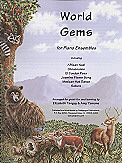 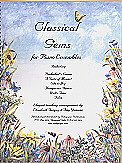 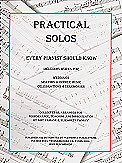
Practical Solos Every Pianist Should Know
Practical Solos is a great book of arrangements of music for ‘special’
occasions. For weddings, one can pick from arrangements of Aura Lee, Ave Maria, the Bridal
Chorus from Lohengrin, an arrangement of Pachelbel’s Canon for a processional, Jesu,
Joy of Man’s Desiring and the Wedding March. The music is arranged so that if a
person has been given a very short notice - as often happens - it can be learned with a
great deal of ease. It is also written in such a way that the pianist can look away
from the music and then easily find their spot again - as often happens in processionals
and/or recessionals. For the ‘developing’ pianist, the music can be used as
written; intermediate and/or advanced pianists can add ornamentation and some
improvisation.
Seating and dinner music includes such selections as About Strange Lands and People
from Kinderscenen, Op 15 by Schumann, Adagio Cantabile from Piano Sonata
Op 13 by Beethoven, the theme from Fur Elise, Moonlight Sonata Theme from Piano Sonata Op
27 no. 2, Ode to Joy from Symphony No. 9 by Beethoven, Prelude in C Major from the WTC
Book 1 by Bach, Romance from Eine Kleine Nacht Musik, K 525 by Mozart, and the
theme from the Piano Sonata in A Major K. 331 by Mozart. Celebrations and Ceremonies music
includes arrangements of Amazing Grace, Auld Lang Syne, For He’s A Jolly Good Fellow,
Pomp and Circumstance, The Start Spangled Banner and Waves of the Danube.
There are no dynamic markings, articulations, tempo markings and pedaling in this
collection. This has been done on purpose so that each piece of music can become a
workpiece where the teacher and student can collaborate on ideas and experience the
artistic process of adding the finishing touches to pieces of music.
My students who have used this collection have been happy to have the chance to learn
this music. As a teacher, I am very thankful to have such a useful book for my students.
We all get the calls on short notice asking "Can you play for my wedding?" or
other occasion. It is very helpful to have this book to use to avoid a lot of last minute
searching for music. Practical Solos Every Pianist Should Know is good not only
for the ‘developing/beginning’ student, but can also evolve into a useful
teaching tool for the intermediate and more advanced student.
World Gems for Piano Ensemble
This is a delightful compilation of duet and ensemble music that students of all ages
love to learn and perform. Included in this collection are African Noel, Choucounne, El
Condor Pasa, Jasmine Flower Song, Mexican Hat Dance and Sakura. I have successfully used
music from this collection in formal student recitals and as ‘pupil savers’
adding a bit of spark and spice to student’s music.
What is so wonderful about this collection of music is its versatility. It can be used
for piano duet, for piano duo, as ensemble music for three or more parts, and with other
instruments such as flute or recorder, strings, voice, clarinet, or oboe and percussion
instruments such as castanets, glockenspiel, maracas, tambourine or triangle. These
arrangements make the music accessible to all ranges and levels of performance and ability
skills. As with most music arranged by Tanguy and Yamane, these pieces are tools to help
let the student grow and learn. Dynamic markings, articulations, etc are not included so
that the the teacher and student can freely discuss ideas about the interpretation of the
individual pieces of music and grow from there.
Classical Gems for Piano Ensembles
These elegant teaching arrangements have been successful in student recitals and as
slices of a "musical cake" for my students to enjoy. The music in this
collection includes arrangements of Pachelbel’s Canon, A Taste of Mozart, Ode to Joy,
Hungarian Dance, Waltz Time and Folia. These pieces can be used as piano solos, for piano
duets, piano duos, ensemble pieces and with different instruments. Where there is an
asterisk in the music, the piano is best used on that page as a countermelody or
accompaniment for another instrument (e.g., cello, clarinet, flute, oboe, recorder, viola,
violin, voice and percussion).
The music is printed in a user friendly manner; each printed page is easy to read and
the arrangements are do-able not only for the intermediate student but also for the
developing beginning student. Again, dynamic markings, articulations, pedaling and other
things have been purposefully omitted from the music. The idea behind this urtext version
is to have the student and teacher become involved in an exchange and evolution of musical
ideas together. I have used this collection of music successfully with beginning and
intermediate students, often incorporating siblings, parents, friends, etc. to play the
other instrument parts and get the students to experience the joys of ensemble playing.
Practical Solos Every Pianist Should Know, World Gems for Piano
Ensembles, Classical Gems for Piano Ensembles, Arrangements by Elizabeth
Tanguy and Amy Y. O'Grady, List prices: $12 each, plus $3 flat shipping fee. Published and
Distributed by Pedagogue Publications, 2044 E. Rainbow Point Drive,
Holladay, UT 84124.
Note: World Gems for Piano Ensemble now available for $6.95 per copy from Hal
Leonard.
by Steve Barta
 Many of us who teach classical
piano often fail to remember that the composers that we are teaching to our students were
famous not only for their written compositions, but also for their success in the art of
improvisation. The list of the masters who were also known for their improvisational
skills would include: Bach, Mozart, Beethoven, Chopin, Liszt as well as many others. These
improvisations were often the basis for future compositions, or were written down either
immediately following the improvisational performance by the composer, or by students
during the improvisational creation itself. Many of us who teach classical
piano often fail to remember that the composers that we are teaching to our students were
famous not only for their written compositions, but also for their success in the art of
improvisation. The list of the masters who were also known for their improvisational
skills would include: Bach, Mozart, Beethoven, Chopin, Liszt as well as many others. These
improvisations were often the basis for future compositions, or were written down either
immediately following the improvisational performance by the composer, or by students
during the improvisational creation itself.
The art of improvisation is something that we as classical pianists and
teachers of classical piano are starting to forget, and in some cases many of us have
either totally forgotten about this art of improvisation or were never taught to love and
appreciate this intricate part of piano/music study. This art of improvisation has turned
over to the artists of jazz and thank goodness they are keeping this art alive and well
for us.
The book The Source by Steve Barta is a
concise and to the point resource book that has traditional and contemporary scales,
chords, inversions, and piano fingerings in it. This is not a theory
book, it does not go into the historical evolution or the
theoretical basis for the scales. It is a no-nonsense collection of all these "tools
of the trade" that one can use as a basis for either learning or expanding their
understanding of improvisation, or for identifying the different types of scales, chords,
or inversions in any piece of music, whether it is classical or jazz.
The book is divided into two sections. Section One
consists of ALL types of scales, written in the treble and bass clefs, going up and down
two octaves, with fingering written in for piano players. Very often, alternative
fingerings are provided, as well. The scales written include: Ionian (major), Dorian,
Phrygian, Lydian, Mixolydian, Aeolian, Locrian, Diminished, Whole Tone, Augmented, Blues,
Major Pentatonic, Minor Pentationic, Harmonic Major, Harmonic Minor, Melodic Minor, Lydian
Augmented, Lydian Dominant, Locrian Sharp Two, Super Locrian, and Chromatic. The
alternative names for the scales are also included, e.g. the Aeolian scale is identified
as the pure minor, natural minor, Ethiopian, and the Mohammedan. The individual scales in
each section are identified by their key signature only; the exceptions to this are the
scales in the Diminished, whole tone, and Augmented sections, these scales are labeled,
e.g. C augmented, F whole tone, etc. We would have liked to have seen all the scales
labeled, not just the scales in the diminished, whole tone, and augmented chapters. Having
these scales at finger tip access has been a help for showing students the different types
of scales and incorporating these scales into our normal technical workout.
Section Two consists of the various inversions and
piano fingering for the five seventh-chord types or qualities. The types include the major
seventh, dominant seventh, minor seventh, half-diminished seventh, and diminished seventh.
Fingerings are given for each inversion of each possible chord situation. The left hand
and right hand fingerings are written on separate staffs and are listed by their letter
name, for example, under "C" one can find the chords and fingerings for the C
Maj. 7, the C Dom. 7, C mi. 7, C half-dim. 7 and the C dim. 7. At the end of Section Two
there is a section called General Chord Information, which gives examples in the key of C
of the above mentioned chords as well as 9th chords, 11th chords, and 13th chords, as well
as a listing of common chord abbreviations (again, given in the key of C).
The Source is a should have book, not only for students and
lovers of jazz, but for all serious students of music. It is a great starting point for
those interested in studying jazz and/or the art of improvisation; one can easily and
readily find the scales and chords they want and then practice to help
develop the needed skills. The book can also serve as a refresher course on scales,
chords, and their spellings/fingerings. Many classical as well as jazz
pedagogy and performance classes at colleges and universities could benefit by including The
Source as part of their curriculum as a concise and helpful resource guide for all
types of scales, chords, etc. You can learn more about The Source and even purchase it
from the Source Music Web site.
The Source by Steve Barta. list price $12.95.
Distributed by Hal Leonard Corporation, 7777 W. Bluemound Rd., P.O. Box 13819, Milwaukee,
WI. 53213. Phone 414-774-3630 Fax 414-774-3259. WWW: http://www.sourcemusic.com/b-source.htm
(24 pieces for piano)
by Steve Dobrogosz
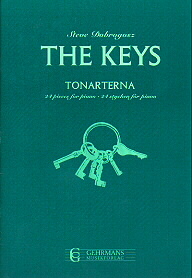 The Keys is a
series of 24 compositions written for students of all ages and geared towards those
playing at the ability level of late beginner to early/middle intermediate level. However,
unlike a lot of beginning repertoire, they do not sound like beginning pieces of
repertoire, which makes them all the more enjoyable to teach. These pieces are a delight
and students love them. The Keys is a
series of 24 compositions written for students of all ages and geared towards those
playing at the ability level of late beginner to early/middle intermediate level. However,
unlike a lot of beginning repertoire, they do not sound like beginning pieces of
repertoire, which makes them all the more enjoyable to teach. These pieces are a delight
and students love them.
Each key is represented by a little piece in The Keys. The
pieces are organized as follows: C Major, c minor, F major, f minor, B-flat major, B-flat
minor, and so on up the cycle of fourths ending with G Major and g minor. Each composition
has its own distinct personality, style and color; for example, the piece in C Major is
marked playful, the piece in c minor is marked spiritual. The collection
includes compositions in Ragtime style, gospel style, a march, reverie and many more.
Although written for the "younger" pianist, this reviewer has had excellent
success teaching these pieces to children, teens, and even adults. The music is not
insulting to the intelligence, nor do the pieces sound like beginning piano repertoire.
The students enjoy learning them and teaching these pieces has also been a great way to
help students overcome whatever fears they might have about playing in ALL key signatures.
It has been interesting to present the a-flat minor example to my
students. Initially, they get very intimidated by the key signature of 7 flats, but after
I explain and show them the patterns involved and the beauty of the composition, the fear
subsides and they can see the music written, rather than be scared off by 7 flats.
Musically the pieces are so enjoyable for the students to practice that they do not mind
having to deal with the key signatures and, thereby, learn to be comfortable with playing
in all the major and minor keys.
We enjoyed teaching these pieces because they make the understanding of
key signatures, the difference between major and minor more real for many students. Also,
we use these pieces as a tool to make theory a reality, but in a musically solid and
beautiful way. The pieces are not overly technically difficult, but each piece does
present it's own challenge; interpretatively or technically. For example, the composition
in b minor, is indicated, sharp and bright, the student has to deal with some chromatic
passage work in sixteenth note patterns, but, as a student pointed out, it sounds like a
solo jazz trumpet showing off, followed by the left hand doing a repeated, dotted rhythmic
chord pattern, which sounds like (according to the same student) the rest of the
instruments in the jazz combo, the bass, the piano and the drums, giving the heart beat of
the piece. The piece before it, in B Major, is indicated with a dancing rhythm;
the same student was delighted to meet 'his fingers on the dance floor' and have them move
about in simple syncopated rhythmic patterns, while the right hand had some fun thirds to
play that had (still according to this same student) a 'cool' sound. There were a few
inner ledger line reading challenges to be met in this piece, but he gladly met them.
The Keys is not geared for the new beginner; the student should
have a solid grasp of basic note reading, key signatures, counting and an understanding of
the concepts of sharp, flats and naturals before attempting these pieces. We have found
this book to be extremely successful with middle school, high school and adult students.
You can visit the home page of the composer of The Keys, an American living in
Stockholm, at
http://www.dobrogosz.com/scorelist.htm.
Take the time to explore this set of 24 pieces with your students; they are delightful
gems of music and will help unlock the doors of playing in all the major and minor keys.
The Keys (Tonarterna - 24 pieces for piano) by
Steve Dobrogosz. $10 list plus shipping. Gehrmans Musikforlag Stockholm, Sweden. Ph.:+46 8
610 0 610. Fax: +46 8 610 0 626. E-mail: order@gehrmans.se.
WWW: http://www.gehrmans.se
Folksongs for Piano - A Classical
Interpretation
Arranged by Cheryl Shantz
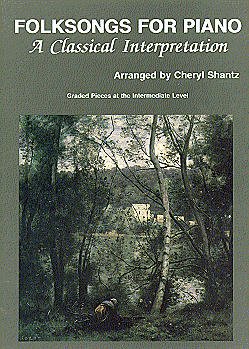 This is a delightful collection
that grows on one with each reading. Prefaced by words from the original song, each piece
gives the pianist a sense of the emotion that generated the music. The melody is treated
in a loose theme and variations fashion, as if depicting each verse of the folksong. This is a delightful collection
that grows on one with each reading. Prefaced by words from the original song, each piece
gives the pianist a sense of the emotion that generated the music. The melody is treated
in a loose theme and variations fashion, as if depicting each verse of the folksong.
From the first composition, each arrangement is quite charming and must
be played expressively to be fully enjoyed. Now, that may sound like a rather obvious
statement, however opportunities are missed if the expressive content of the piece is not
paramount to the technical demands. Specifically, one can describe the texture of these
pieces (i.e. a single line melody in the RH set over a broken chord LH accompaniment in
4-bar phrases at a moderate tempo). But when the term affetuoso enters the
picture, one is alert to the communication inspired by the words of the folk song. Because
of the composition's melodic origin in vocal music, each piece gives the pianist an
opportunity to explore phrasing and breathing (as any good singer does!). And, too,
because of the vocal nature of the works is so apparent, the demands of listening to the
balance of melody and accompaniment are made plain.
For the teacher working with a student on these arrangements, there is a
full range of teaching "nuggets" to "mine" from the nit-picky
coordination of RH/LH to the overall musical sense and energy of each work.
A brief description of each arrangement:
Fair Sally. The first verse is simply stated in a single line
melody, with broken chord accompaniment. This is followed by an Alberti bass figure with
melody, ending with a meandering RH melody with a chorale like coda drawing the piece to a
close.
Oranges and Lemons. "Oranges and Lemons say the bells of
St. Clement's" are the words for the inspiration of this bright arrangement.
Technical demands include octave and a half scale runs in the RH and arpeggiated patterns
for the accompaniment.
The Blacksmith. A tragic tale is implied in the verse quoted,
and musically the piece opens homophonically, simply with dolente indicated.
Again, accompaniment figures tend to be broken chords. The RH melody is a bit more
rhythmically interesting with syncopations of the line explored. Midway there is a Piu
mosso where 16th note patterns dominate the RH while the LH takes the melodic role.
Down By The Salley Gardens. A familiar song performed by many
vocal students, this arrangement for piano raises the demands on the pianist by having the
melody and a secondary line expressed by the RH over a broken chord LH accompaniment.
Greensleeves. Another very familiar folksong, this piece starts
simply until the page is turned and then becomes progressively more challenging. It gives
the pianist an opportunity to develop a sure sense of scales and arpeggios in the LH while
the RH is independently stating the melody in occasional 6ths and octaves.
Scarborough Fair. The last arrangement in this collection is,
pianistically, a culmination of the technical challenges offered in the previous works,
especially requiring independence and balance of the two hands.
My overall impression is that these arrangements are quite tuneful,
harmonically true to the individual work as well as to the folk idiom. The only slight
criticism one might have is in the use of the broken chord accompaniment as the primary
mode of accompaniment. There are good challenges to the independence of hands, and the
choices for key areas are quite accessible. This collection would be good for the
intermediate/late intermediate junior high/high school student or adult student with an
interest in folk music: a good "leavening" to the usual repertoire.
Dr. Jane L. Viemeister
Folksongs for Piano - A Classical Interpretation.
Graded Pieces at the Intermediate Level. Arranged by Cheryl Shantz. 1994, Warner Bros.
Music Australia, distributed by Kallisti Music Press in the USA
|
|
![]() The Piano Education Page, Op. 10, No. 2,
https://pianoeducation.org
The Piano Education Page, Op. 10, No. 2,
https://pianoeducation.org